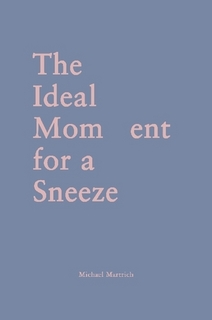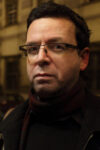Michael Martrich is a writer living in Dakar, Senegal, author of The Hole in the Den (BlazeVOX, 2017), as well as, the book under review. I was formally introduced to Michael online, via his brother, Andy Martrich, also, a writer, who I was introduced to, in turn, by J. Gordon Faylor, Editor-Publisher of Gauss PDF. Each of these fellow-writers has become my virtual friend at personal and professional levels, attesting to the power of the internet to foster positive interactions and networks of individuals with common interests. Upon receiving a copy of The Ideal Mom ent for a Sneeze, I immediately began to read it, initially, out of curiosity, eventually, because of its impact upon my intellectual, sensory, and aesthetic processes. The collection is, precisely, the sort of experimental text that my own practice is devoted to; and, I became committed to sharing Michael’s most recent project with consumers of innovative literature, as well as, those uninitiated to literature that disrupts our conventional expectations about what a poem should be and do. This Review-Interview was conducted via email, and I have made no changes to the author’s replies.
We are holes within a screen door, an entrance for flies. [78-79]
Communication is a gravity and a gravy from within and between us and other things, and within it we sediment and solidify together within variants and levels of meshes, an invisible and dynamic Merleau-Pontian flesh and chiasm, Deleuze-Guattarian planes of immanence. Within this invisible G~dly crabgrass, Ishmhal learned, necessarily, to nest, to take shape, to leave and forget his ghost (as we all do, together). [148-149]
Clara B. Jones: Thanks for agreeing to participate in this project, Michael. My purpose in this Review-Interview is to provide an overview of your new collection, The Ideal Mom ent for a Sneeze, in the context of the genres often termed Experimental or Innovative or avant garde Poetry. A goal of mine is to convince our audience that the book is a necessary “read,” as I found it to be, because, among other reasons that I advance below, the text invited me to participate in a performance of indeterminacy [“undecidability”] that challenged me, not only, to bear the responsibility for singular interpretation—or not—but, also to serve as a “happening”—to use the text as a platform for novel or creative or associative or variegated or intellectual or emotional representational or non-representational experiential raw-material. Before we address the book directly, I’d like to get an idea of you as a person and as a craftsman whose tools are words, phrases, and sentences; thus, imagine that you have invited three poets to dinner. Who would these poets be, and why did you invite them? What would you serve for dinner, what wine would you select, and what would the four of you talk about?
Michael Martrich: First of all, thank you for inviting me to participate in this project!
As far as my own invitations for this hypothetical dinner party, I’m asking Boubacar Boris Diop, James Baldwin, and Clarice Lispector. And since I live in Dakar, how could I serve anything other than a communal bowl of thiebou jën? Drinks are typically not consumed during the meal, and being in Senegal, it might be best just to forgo wine, altogether.
After the thiebou jën—as it’s rude to converse during the meal— Wait. Let me back track. I’m not worried about whether or not my company identifies strictly as poets, similarly to how I’m not worried about whether or not my work is poetry, or if I’m a poet. I may have Susan Howe’s Souls of the Labadie Tract on repeat, so I’m not completely devoid of poetry or poetic study, but ultimately I’m searching through any oblique passage to figure out why I’ve been running away with one hand reaching backwards. I’ve settled in Senegal, where I realize I lack the courage to even remotely run away. Instead, I exist on an outside of a Senegal that has been increasingly at a crossroads of what I naïvely and too-simply see as on the Senegalese end—a promise that communication could once again return to its omniscient spiritual grounding and connectivity—and at the other end—the violent and omniscient globalization that is my foundation and from which I cannot separate myself, and is the privilege to find myself in Senegal in the first place.
So I would stay silent. Diop, next to me and with his hand on my wrist, would be my guide, as he would be in quiet discussion with Baldwin, who would eloquently deliver his stance as an outsider from within these violent systems. And there would be Lispector, silent in her mystical stare behind cigarette smoke, having never touched her side of the thieb, who would suddenly and politely excuse herself to leave for another social engagement—most likely where wine was being served—and keep the cosmic solution tucked deeply within, unreachable to the rest of us.
I am going to ask a question that would be very annoying to most of the Experimental Poets I know: What is Sneeze about? As you respond—or not—to the question, can you describe the book to us?
It’s all about the physical crease running through the middle of the paperback book, which renders the PDF version somewhat obsolete. Since the outer margins on the left page are wide enough to allow for the perhaps appropriated (and non-appropriated) passages along the side—suggesting an organization of busy, gridded striation—the main text is set far into the page and currents through the crease into the entire right page, or the smooth side leading to the oceanic. The crease provides a constant shoreline for the reading to tide back and forth, which is central to the protagonist, Ishmhal, who comes back to shore from a Deleuze-Guattarian sea to discover the world he comes back to has unzipped, leaving him precariously unseen: not here nor there. In short, Ishmhal cannot return to the former world from which he had set out, and yet he would die out at sea. He has become the-old-man-and-the-seam, requiring the crease—the shoreline, the beam—to maintain an oblique balance and sanity. This is straight out of A Thousand Plateaus, where being pegged to striation is not the worst that can happen; the worst is reserved for those Bodies without Organs gone too far out to sea and losing too much (organ)ization.
This jouissance with the crease also represents a unifying vertical line amidst an aggrandizing horizontal fragmentation. And it is here I equate Western Progress with the horizontally suburbanized and spread-out fragmentation from lived experience, as we might see in Cheikh Hamidou Kane’s Ambiguous Adventure and Maurice Merleau-Ponty’s chiasm or flesh. From Ambiguous Adventure, we hear an exclamation of horror about the colonial imperialists: “‘Master, they have no more bodies, they have no more flesh. They have been eaten by objects. In order that they might move, their bodies are shod with large rapid objects. To nourish themselves, they put iron objects between their hands and mouths. That is true!’” Here is a disappearance of the person as a result of separation from lived experience.
And while Merleau-Ponty finds that the dominance of science encourages seeing the world in a vacuum, and therefore outside of lived experience, it’s the separation from lived experience through a shoddy communication that attracts me. When Ishmhal returns to land, he is not only able to vaguely sense his former communities as “no more bodies…no more flesh,” but he, too, disappears, when he realizes that he only appears to others as potential economic or gainful (Laingian family game-theory) avenues that he cannot fulfill. What is missing is a Merleau-Pontian flesh, the nonmaterial, unifying, chiasmic intertwining—verbal and otherwise—between and throughout others and one’s world. This is what gives us flesh, makes us seen and felt. We have fragmented ourselves out of an organic communication that explores the human (not economic) exchanges—the give and take—of the senses, of the human experience. The gravity and gravy of communication has been squandered by a communication that is bullish advertisement, a car-fueled grid stretching endlessly suburban, and superficial/representational formality. As a result, the unity provided by the crease cannot hold. In the end, that final sneeze scatters All horizontally.
Responding to a comment made by Kenneth Goldsmith that Conceptual Poetry is not intended to be read and is about nothing, Marjorie Perloff demurred, stating that all writing is a reflection of an author’s choices. What particular decisions did you make when creating Sneeze? Would you say that the book is a reflection of conscious, even, intentional choices? For example, you position a section that is, in effect, an Index, at the beginning of the book. Also, you place in quotation marks or italics certain textual elements, suggesting to me that these are “found” or appropriated components. Related to this, the text seems like a Wittgensteinian “language game” making it difficult to determine what elements are your own words or not; although, I did note a particular “associative” style [as in the epigraphs above] that I believe is your own signature. I’d, also, be curious to know whether your book is intentionally political or disruptive or oppositional?
I’ve already suggested how form is a message in the preceding question, so I can no longer hide from the fact that it was intentional. The layers, planes, puns are intentional constructions on my part, functioning as the reader’s rhizome simultaneously and intersubjectively within the closed system of the physical book and through possible digressions outside the book, as well. After all, the apparently appropriated material running throughout nudges the reader to search it out elsewhere, leading other readings to further sediment the setting of Sneeze.
In the closed sense, the table of contents is a poem in itself, and works nicely as an epigraph for the entire piece. The “In Contexts” as an index at the start of the book allows readers to immediately navigate by taking terms and ideas and developing layers of definitions within the varying contexts throughout the book.
None of these conscious decisions seek to deconstruct, necessarily, but to provide possible lines of flight within, without, and all around, all in the names of construction and reconstruction. We have enough rubble. I want to put this back together, even though, in the end, of course, the impossible unification slips away like Lispector from the dinner party.
Tyrone Williams, writing recently in jacket2, made the following distinctions between “innovative” and “experimental” writing. What is your interpretation of Williams’ perspective? Would you classify Sneeze as a particular “type” of experiential writing? To quote Williams:
“The distinction I draw between innovative and experimental writing is analogous to that between new ‘paradigms’ confirmed by extensive and redundant experiments and initial, tentative experiments that fail more often than they succeed. Of course, in failing they also serve to narrow the spectrum of hypotheses on the basis of which experiments are carried out. In short, innovative writing is writing canonized, however temporarily, among a community of poets and the infrastructures (presses, magazines, academia, etc.) that support them. Experimental writing is, by definition, just that: an experiment, a testing of an aesthetic, social, or political hypothesis in writing not yet widely endorsed. Neither innovative nor experimental writing is reducible to form. Finally, the traditional parameters of aesthetic taste and judgment cannot be mapped onto writing simply because it is either innovative or experimental since the relationship between innovation and experimentation is largely a matter of cultural capital.”
My father once told me that at his high-school library, they had a shelf of books that were off- limits and needed special permission to access. He received that permission as a 15 or 16 year old, I’m guessing, and I often imagine him silenced before that shelf and just staring, hesitant, fearful even, before this row of old, dusty books.
This is where he discovered Kant. And he told me that he didn’t understand much in Critique of Pure Reason, but it didn’t matter. It’s one of the most beautiful stories I’d ever heard—this small tale from my father. This is how I see my father beneath the surface. Here was real silence, mystery, and transcendence: something so difficult to grasp, but sacred in its depth and impenetrability; something that takes a long time; something that takes us out of the apparent world and into the real. I don’t worry whether or not my writing is innovative or experimental. I only want to be on that bookshelf, the one that’s off limits, that requires special permission to access, that has to be found and sought after from a queer distance.
In her book, The Futurist Moment, Perloff has written, famously, about “collage” poetry, a classic form employed by experimental poets creating text poems as well as vispo. Please describe your reasons for utilizing a collage format; in particular, discuss how the format and the text are synergistic.
While what I’m doing is a kind of “collage,” I’ve also thought of it as a diary. The writing of Sneeze, now that it is recorded as a book, is not only a snapshot of the text I was writing, but also of what I was thinking, reading, listening to, or came across in an email or elsewhere at the time of writing the main—or, tidal—text. In a way, it documents the ways in which I was never quite removed from writing Sneeze, as found passages from anywhere would be the biscuit taking me back to the tidal text, and I would paste these passages within the margins where they provided supplemental lines of flight that could lead in, back around, and elsewhere: into other books, thoughts, or internet searches. This models an intersubjectivity, where the “objective” snapshot of this time in my life remains monolithic, but is coupled with not only the reader’s a priori experiences to the book, but also the open lines of flight that might morph and warp the closed system.
Simultaneously, these side passages dress the setting in a way that keeps our attention on the situations and frames of the dominant society rather than on the single protagonist. Stated somewhat differently, the “collage” of found material allows us to focus on setting—which is heavily mapped through a “nonfiction” of essays and reviews—rather than the protagonist. This uproots and reroutes American Capitalism’s obsession with the unadulterated free-willed individual—whose supposed choices have landed her in hell—to the more accurate depiction of the initial Hell and Grand Frame from which we’ve all risen.
Another characteristic of Experimental Poetry is “indeterminacy,” as mentioned above. How does Sneeze utilize this technique [“…a few onlookers looking into the precipice of uncertainty.” (178)], and how does “indeterminacy” enhance your project?
I don’t think we should be looking for direct answers. How frustrating is that—people requiring Answers? And far worse than that are the writers and prominent figures with the direct solutions to our problems.
Indeterminacy takes us out of the flawed obsession with categorization, the endless and unreadable fine print and data, the patriarchal proof. We need writing, thinking—even instruction—that allows us to create a space for our ever-spreading horizon to marinate, to circulate, to transcend the apparent surfaces through a kind of permanent parabasis of the horizon. Perhaps I aim for a kind of mysticism, and I don’t deny it.
What are you reading now, and who among emerging poets would you recommend to our audience?
In regards to poetry, I most recently read Matthew Rotando’s Hail, which is a collection of poems that have captured what I’ve been discussing throughout our interview, and could serve as a kind of companion to Sneeze. In a review, I open asking, “Is there no other way but to hail that which hails upon us?” and conclude with what could easily be mistaken for a passage from Sneeze: “We’ve been frozen since birth, and once we break through, there is no other side. There is no foundation somewhere else. Out there is as invisible as our own organ-less selves drifting ghostly amongst ‘a faint smell of unpopped popcorn and a vast and endless space.’ And within this unseen, somewhere else, we remain paralyzed: buoys in boredom, loneliness, and without any direction. But this time we can see the hail, and it falls in the distance, and it falls over slick, sedimented hills and onto broken shores and calculated streets and buildings from an unseen, almighty somewhere else.”
Are you working on any new projects that you’d like to tell us about?
I’m in the beginning stages of crafting a mystical text set as a faux primary-source from the future. It’s vaguely based on reimagining Laure Pigeon’s spiritualist practice of spiralling blue-ink drawings, but as a base from which I construct a mumbling prophetic philosophy of misconception, layered meanings and puns, hesitation, and pessimism that lifts one out of the apparent world and into the cosmic.

Coda: Martrich’s comments about “collage” poetry mirror a common effect of experimental and avant garde writing that provides a reader with the raw material for combination and re-combination of elements—graphemes, morphemes, phrases, sentences. Conscious and unconscious manipulation of these components surrender “interpretation” and “meaning” to the reader, as all post-modern literature does. Alternatively, the reader is not obliged to analyze a “collage” composition, permitting it, rather, to stand alone without mining it textually, without deconstructing it formally, without having a rule-governed gaze. For example, I once created haikus from poems that were computer-generated, demonstrating that experimental poetry can embody the criteria of Formalism, in this case, what the poetry critic, Helen Vendler, calls, “interpretive power.” As another example of personal referentiality, when considering the title, The Ideal Mom ent for a Sneeze, “Mom” captured my imagination, and I wondered whether Martrich might have, purposely, sought to emphasize, then, trigger thoughts of psychoanalytic theory, particularly, the “Oedipal Complex?” Unlike many experimental texts, the reader will find that Martrich’s new book includes features that unify the writing from beginning to end—particularly, repetition of technique, form and content, as well as, compartmentalization within and between “chapters.” Any consumer of fine literature, whatever their motivation, will find The Ideal Mom ent for a Sneeze, a very “good read,” indeed. This book deserves a wide audience, and Michael Martrich deserves to be recognized as one of our exemplary practitioners of innovative writing.
Clara B. Jones is a knowledge worker practicing in Silver Spring, MD, USA. Among other writings, she is author of the collection, Poems for Rachel Dolezal (GaussPDF, 2019). Clara, also, conducts research on experimental literature, radical publishing, as well as, art and technology.
This post may contain affiliate links.







